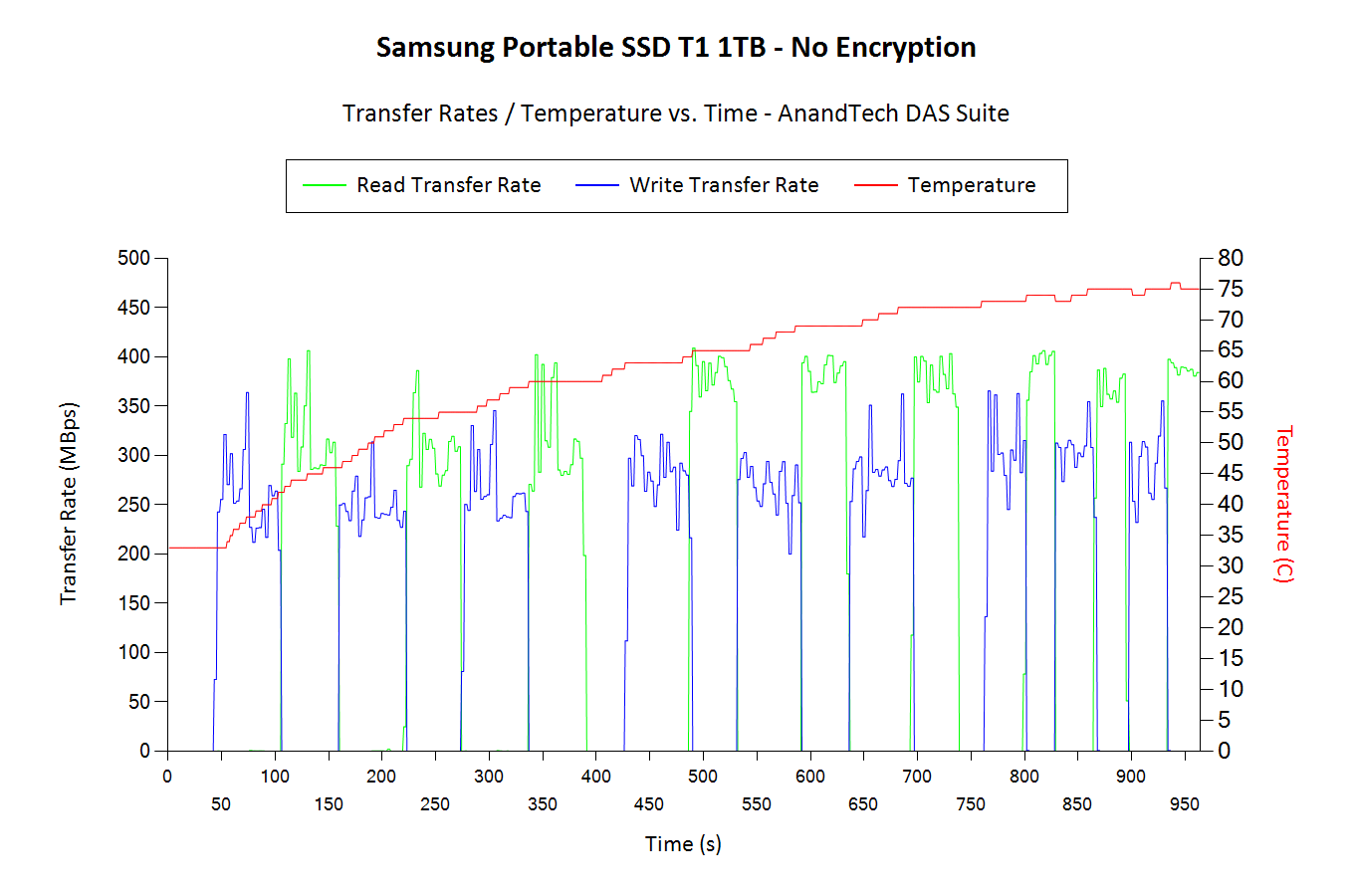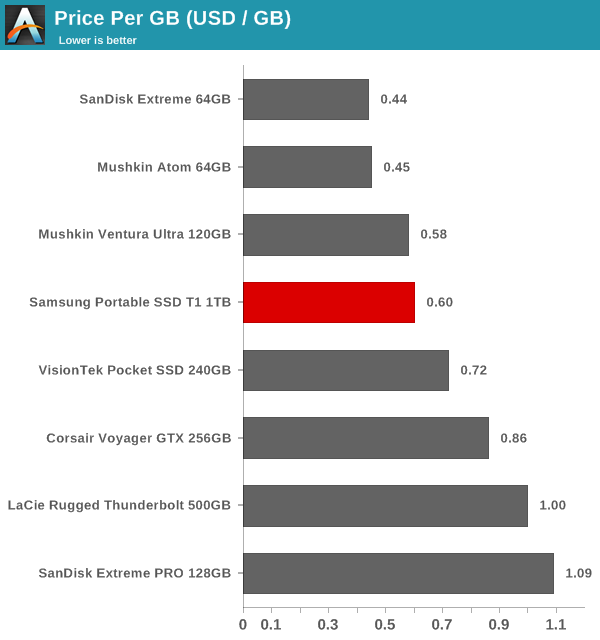Samsung Portable SSD T1 Review
by Ganesh T S on January 20, 2015 10:00 AM ESTPerformance Consistency and Concluding Remarks
Yet another interesting aspect of these types of units is performance consistency. Aspects that may influence this include thermal throttling and firmware caps on access rates to avoid overheating or other similar scenarios. This aspect is an important one, as the last thing that users want to see when copying over, say, 100 GB of data to the external portable SSD, is the transfer rate going to USB 2.0 speeds. In order to identify whether the drive under test suffers from this problem, we instrumented our robocopy DAS benchmark suite to record the flash drive's read and write transfer rates while the robocopy process took place in the background. For supported drives, we also recorded the internal temperature of the drive during the process. The graphs below show the speeds observed during our real-world DAS suite processing. The first three sets of writes and reads correspond to the photos suite. A small gap (for the transfer of the videos suite from the primary drive to the RAM drive) is followed by three sets for the next data set. Another small RAM-drive transfer gap is followed by three sets for the Blu-ray folder.
An important point to note here is that each of the first three blue and green areas correspond to 15.6 GB of writes and reads respectively. For the Samsung Portable SSD T1, we see throttling kick in only after more than 200 GB of data has been transferred continuously (the last two sets of reads in the graph below). The throttling seems to kick in after the drive temperature reaches 75 C. Another interesting aspect is the fact that the temperature rises a bit faster in the case where encryption is enabled.

A Note on TRIM
TRIM support would be really handy for a portable SSD. Usually, we don't see TRIM working over USB. However, the Corsair Voyager GTX with the Phison controller does support TRIM over the USB 3.0 interface. In addition, that drive also supports manual overprovisioning. The T1 has in-built overprovisioning, but manual control over it using the Samsung Magician software would also be nice. Of course, it is also arguable that TRIM and overprovisioning are not really needed for the T1's target market. However, for cases where the T1 is used as a portable OS drive (Windows-To-Go or some sort of portable Linux install), those features could improve user experience.
The internal platform of the T1 (the 850 EVO) does support TRIM. However, Samsung indicated that neither Microsoft nor Apple currently support issuing TRIM commands through the USB interface on their current OS. That said, they are exploring additional methods of forcing TRIM - including manually through the Samsung SSD Magician software. That feature will not be available in time for the launch, though.
Concluding Remarks
Coming to the business end of the review, the Portable SSD T1 brings Samsung to the forefront of external flash drive solution vendors. Keeping the flash fabrication, controller design and fabrication as well as the solution design in-house has enabled it to put out the most reasonably priced (if not, the only) 1TB external flash drive product in the market. The size and weight of the unit are both small enough to actually let the drive hang off the USB 3.0 port as a flash drive. That said, Samsung supplies a very short USB 3.0 cable - it is perfect for notebooks, but not so in the case of desktops with USB ports in the front or rear panels.
The performance of the drive leaves us with no doubt that it would be a great portable OS drive / Windows-to-Go solution, even though Samsung doesn't advertise it for that purpose. Unfortunately, Samsung has not decided to pursue the certification process. As far as non-enterprise consumers go, this is perfectly acceptable - the performance for Windows-to-Go is there without the extra cost associated with obtaining the certification that eventually gets passed on to them.
The only minor points of concern is the inability to recognize and take actions on the drive based on S.M.A.R.T features such as TRIM.

The 1TB 840 EVO mSATA SSD has been in the market for quite some time now. Hence, the size of the Portable SSD T1 didn't come as much of a surprise. From an end-user perspective, the size / capacity of the drive and the price point ($0.60/GB) are very attractive. The Portable SSD T1 makes for a compelling solution where fast transfers of large amounts of data is needed in a secure environment.










68 Comments
View All Comments
mczak - Wednesday, January 21, 2015 - link
If it's just a broken partition table, this should indeed work just fine. It isn't obvious from the article though how this actually works - if the drive needs some special commands to be sent or anything like that this won't do.bill.rookard - Tuesday, January 20, 2015 - link
I'm a bit curious as to the premium price. One wasn't listed, but at .60/GB that comes to around $600 USD for a 1TB drive. Perhaps it's the format itself, but just simply looking on Newegg shows:1) 850 EVO VNAND 1TB 2.5" drive at around $475 USD
2) USB 3.0 2.5" drive enclosure at around $10 USD
That would get us virtually the same performance (if not identical performance) to the T1 at albeit a slightly larger physical size. My question is how many people consider the slightly smaller physical footprint worth the 15-20% increase in price?
Flunk - Tuesday, January 20, 2015 - link
A custom enclosure like this costs more to produce. There is no way that they could sell it for only $10 over the bare drive. Some people prefer to buy pre-assembled drive units and because of that there is a bit of a premium. So yes, there are definitely buyers out there for this.bill.rookard - Tuesday, January 20, 2015 - link
I would certainly agree about the custom enclosure being a little more expensive than your typical 2.5" drive China-built enclosure, but the other thing to remember is that the prices I quoted are also -retail- prices currently available.I'm sure that Newegg isn't paying Samsung $475 for that drive that they're turning around on their site (take off 5-10% for markup and an extra 20% for a 'premium' drive like the 850 pro) and it's probably closer to $350 at wholesale costs. At $350 for wholesale prices, that means the drive itself is probably close to $125-$130 for Samsung to produce.
The drives themselves are very similar in parts (all have controllers, pcb's, NAND chips, etc) and with the ONLY differentiation being the case itself, it's interesting that this drive would retail for more than your average mid-spec'd AMD -system-. While I'm all for being up on the latest technology, IMHO this drive needs to come down on price before people would probably even consider buying it.
jhoff80 - Tuesday, January 20, 2015 - link
I think a more fair comparison would be to an mSATA drive, which is closer to the size of this. Even still, the 1TB 840 mSATA drive is under $500 as well.baii9 - Tuesday, January 20, 2015 - link
And with a Mata/2.5 drive, you can always pop it out to trim if it comes down to it, 500+gb data are not easy to move around for formatting the driveAJSB - Tuesday, January 20, 2015 - link
The real problem here is DATA RETENTION.As soon as drive is disconnected, the NAND cells start to loose charge and they loose much much faster than a HDD...how much time till this drive "implodes" ?
akdj - Tuesday, January 20, 2015 - link
Seriously? First I've heard of an SSD 'implod(es)ing'???NAND is pretty reliable. It's been in most smart phones for a while and I've yet to see an Android or iPhone implode. That said, I've yet to own a Windows phone. Hmmm
andychow - Tuesday, January 20, 2015 - link
According to JEDEC spec the P/E cycle rating is with one-year data retention. So after 6000 P/E cycles the data will still be good for 1 year while the SSD is disconnected.On a drive with just a few P/E cycles, it's likely to be over 10 years of data retention.
This isn't regular tlc nand, this is 32-layer tlc v-nand on a 40nm process.
Regular HDD suffer from kinetic shock and vibrations. This does not.
AJSB - Tuesday, January 20, 2015 - link
That JEDEC DATA refers to what kind of NAND ?SLC, MLC , TLC or V-NAND ?...and with witch lithography ?
As NAND cells go down in size, they got worse in DATA retention....i heard that 15nm will last only weeks removed from a PC (this is not same as PC switched off, because even when switched off, a SSD is still working at low level of energy doing its thing to keep cells charged).
Granted, this uses 40nm and in 3D witch makes it much much more reliable...i read a good article about this V-NAND from SAMSUNG and it's very well designed in its cell structure.
As for HDDs, one thing is 3.5" HDDs another is 2.5" HDDs...2.5"s are designed for Notebooks with special sensors,etc., granted, some more than others, and they can stand a LOT of abuse...i had a Toshiba Notebook long ago and was working w/ it as battery was charging, suddenly i needed to go away and forgot cable of AC/DC brick and stumble on it...the Tosh fled away in the air and hard land in hard floor face done....all this as HDD was working in video editing !
I thought "it's done"...no it wasn't (well, the hinges of LCD didn't like the hard fall) !
The HDD not only wasn't damaged but it didn't lost/corrupt DATA !
Believe me or not...this happened more than once.
Because of this i trust a LOT in 2.5" HDDs of good brands.